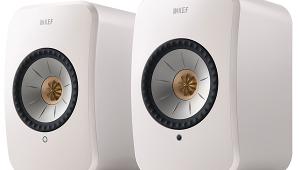How about, "Anything plus the Chromecast Audio"? Forget 3rd party apps, you want native app support with casting.
Wireless Wonders: 7 Wireless Speakers Reviewed Bluesound Pulse Flex
PRICE $299
AT A GLANCE
Plus
Great sound, especially in stereo
Plays hi-res audio
Good connectivity
Minus
Limited bass
THE VERDICT
A suprisingly capable entry point into Bluesound’s hi-res ecosystem
Made by the same company responsible for the design of PSB and NAD products, the Bluesound ecosystem features speakers and associated electronics for audiophiles who are ready to go wireless. The Bluesound lineup includes streamers and streamer/amps that you can attach to your own choice of speakers; there’s also a range of powered speakers, starting with the $299 Pulse Flex.
The Pulse Flex’s driver configuration consists of a 3.5-inch woofer and a 1-inch tweeter, each powered by a separate 10-watt amp. But while this speaker may be small, it’s as full-featured as any other in the Bluesound family. Along with Wi-Fi, it has aptX Bluetooth, wired LAN connectivity, a USB port for hooking up a thumb drive with music files, a combined Toslink digital/3.5mm mini analog input, and a headphone output. It supports streaming of hi-res files up to 192 kilohertz/24 bits in the FLAC, ALAC, WAV, and AIFF formats. Streaming services in the Bluesound app include Spotify, Tidal, Deezer, and Slacker. As with several other speakers in our roundup, a Pulse Flex pair can be linked to play in stereo mode.

Setting up the Pulse Flex was simple, though I did have to dig through support pages on the Bluesound Website to learn about stereo pairing and how to stream from PC/Mac or NAS drives. A Configure Player menu lets you set Player (Room) name, adjust indicator brightness (important in a bedroom since the Pulse Flex has many bright-beaming indicator LEDs), and configure music services and audio settings (tone controls, etc.). Another panel lets you select between individual speakers on the network to control source/volume or group them together for simultaneous playback/volume control. Configuring these functions proved painless, and the settings remained consistent each time I powered up the system.
When I listened to “Space Song” from Beach House’s Depression Cherry, the tiny Pulse Flex did a good job presenting the track’s rich, reverb-heavy mix. Bass, not surprisingly, was limited, and pushing the volume much past a medium setting made the presentation sound strained. Vocals remained clear and consistent, however, even when I was starting to max out the speaker’s capabilities.
With a linked pair of Pulse Flex speakers in stereo mode, a track like “Silhouettes (I, II & III)” from Floating Points’ Elaenia had an expansive stereo soundstage. Drums came across as firmly centered in this fusion-era Miles Davis–inspired track, with electric piano and bass weaving in from the left and right alongside the ambient bed of vocals. All said, the Pulse Flex pair delivered an impressive hi-fi experience for its size and price.
Just as I was wrapping up this article, Bluesound surprised me with an updated version of its BlueOS control app. I’m glad it came through in time, since the new app is a big improvement on the pervious version. Navigating between playback and room/player control modes— something I’d previously found a bit confusing—can now be done seamlessly. The new version also supports the Apple Watch, if you happen to own one of those things. As with all the other speakers I tested, listening to Spotify involves separately launching that app and using Spotify Connect to link to the system via Wi-Fi or Bluetooth. I also liked the Bluesound app’s Playlists feature, which made it easy to accumulate a list of recently played albums/tracks that I could return to again, shuffle, or save as a separate playlist.
Specs
3.5 in woofer, 1 in tweeter
Inputs: Optical/analog (combo), Bluetooth
Output: Stereo analog 3.5 mm
Dimensions (WxHxD, Inches): 4.92 x 7.2 x 3.9
Weight (Pounds): 2.7
Related: What You Need to Know About Wireless Multiroom Music Systems
- Log in or register to post comments
































































